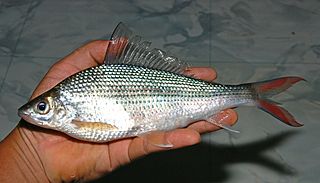
The Cyprinidae are the family of freshwater fish, collectively called cyprinids, that includes the carps, the true minnows, and their relatives. Also commonly called the "carp family", or "minnow family", Cyprinidae is the largest and most diverse fish family and the largest vertebrate animal family in general, with about 3,000 species of which only 1,270 remain extant, divided into about 370 genera. They range from about 12 mm to the 3-m Catlocarpio siamensis. The family belongs to the ostariophysian order Cypriniformes, of whose genera and species the cyprinids make up more than two-thirds. The family name is derived from the Ancient Greek kyprînos.

Salmon is the common name for several species of ray-finned fish in the family Salmonidae. Other fish in the same family include trout, char, grayling, and whitefish. Salmon are native to tributaries of the North Atlantic and Pacific Ocean. Many species of salmon have been introduced into non-native environments such as the Great Lakes of North America and Patagonia in South America. Salmon are intensively farmed in many parts of the world.

Catfish are a diverse group of ray-finned fish. Named for their prominent barbels, which resemble a cat's whiskers, catfish range in size and behavior from the three largest species alive, the Mekong giant catfish from Southeast Asia, the wels catfish of Eurasia, and the piraíba of South America, to detritivores, and even to a tiny parasitic species commonly called the candiru, Vandellia cirrhosa. Neither the armour-plated types nor the naked types have scales. Despite their name, not all catfish have prominent barbels or "whiskers". Members of the Siluriformes order are defined by features of the skull and swimbladder. Catfish are of considerable commercial importance; many of the larger species are farmed or fished for food. Many of the smaller species, particularly the genus Corydoras, are important in the aquarium hobby. Many catfish are nocturnal, but others are crepuscular or diurnal.

Pollock or pollack is the common name used for either of the two species of North Atlantic marine fish in the genus Pollachius. Pollachius pollachius is referred to as pollock in both North America and the United Kingdom, while Pollachius virens is usually known as coley in the British Isles. Other names for P. pollachius include the Atlantic pollock, European pollock, lieu jaune, and lythe; while P. virens is also known as Boston blue, silver bill, or saithe.

A fishery is the enterprise of raising or harvesting fish and other aquatic life. Commercial fisheries include wild fisheries and fish farms, both in fresh water and the oceans. About 500 million people worldwide are economically dependent on fisheries. 171 million tonnes of fish were produced in 2016, but overfishing is an increasing problem -- causing declines in some populations. Recreational fishing is popular in many locations, particularly North America, Europe, New Zealand, and Australia.

Crappies are a genus, Pomoxis, of North American freshwater fish in the sunfish family Centrarchidae. Both species in this genus are popular pan fish.

Pisces (♓︎) is the twelfth astrological sign in the Zodiac. It is a negative, mutable sign. It spans 330° to 360° of celestial longitude. Under the tropical zodiac, the sun transits this area between February 19 and March 20. In sidereal astrology, the Sun currently transits the constellation of Pisces from approximately March 12 to April 18. In classical interpretations, the symbol of the fish is derived from the ichthyocentaurs, who aided Aphrodite when she was born from the sea.

Fish are gill-bearing aquatic craniate animals that lack limbs with digits. They form a sister group to the tunicates, together forming the olfactores. Included in this definition are the living hagfish, lampreys, and cartilaginous and bony fish as well as various extinct related groups. Around 99% of living fish species are ray-finned fish, belonging to the class Actinopterygii, with over 95% belonging to the teleost subgrouping.

Fish are very diverse animals and can be categorised in many ways. This article is an overview of some of ways in which fish are categorised. Although most fish species have probably been discovered and described, about 250 new ones are still discovered every year. According to FishBase, 34,300 species of fish had been described as of September 2020. That is more than the combined total of all other vertebrate species: mammals, amphibians, reptiles and birds.

Labiobarbus is a genus of cyprinid fish found in Southeast Asia. It currently contains nine described species.

Haplorchis taichui is a species of intestinal fluke in the family Heterophyidae. It is a human parasite.

Labiobarbus ocellatus is a species of cyprinid fish from Asia that occurs in Malaysia and Indonesia.

Labiobarbus lineatus is a species of cyprinid fish found in Thailand.
Labiobarbus siamensis is a freshwater fish of the family Cyprinidae native to the rivers of Thailand.
Labiobarbus cyanopareja is a freshwater fish of the family Cyprinidae endemic to the Philippines. This species is of doubtful validity and some authorities consider that L. cyanopareja is a junior synonym of Osteochilus vittatus.

Labiobarbus fasciatus is a species of ray-finned fish in the genus Labiobarbus found in Indonesia and Malaysia.

The signal barb is a species of ray-finned fish in the genus Labiobarbus found in the southern Malay peninsula.
Labiobarbus lamellifer is a species of ray-finned fish in the genus Labiobarbus found in eastern Borneo.
Labiobarbus sabanus is a species of ray-finned fish in the genus Labiobarbus endemic to the Kinabatangan and Segama river basins in Sabah.














